SCAMPER Model Application: Generating Ideas for Toothbrush Redesign
VerifiedAdded on 2023/06/11
|5
|1070
|441
Creative Assignment
AI Summary
This assignment focuses on generating innovative ideas for redesigning a toothbrush using the SCAMPER model. It presents twenty-one ideas developed through the SCAMPER framework, exploring substitution, combination, adaptation, modification, alternative uses, elimination, and rearrangement. The chosen concept is a tooth stick with an adjustable handle and a disposable toothpaste section, emphasizing convenience and environmental friendliness through the use of steel and bamboo. While other ideas like a toothbrush with a mirror or music player were considered, they were ultimately rejected due to safety and practicality concerns. The selected design aims to provide a complete and eco-friendly dental hygiene solution, promoting teeth whitening and anti-sensitivity, encapsulated by the tagline 'Pocket sized solution for all dental problems.'
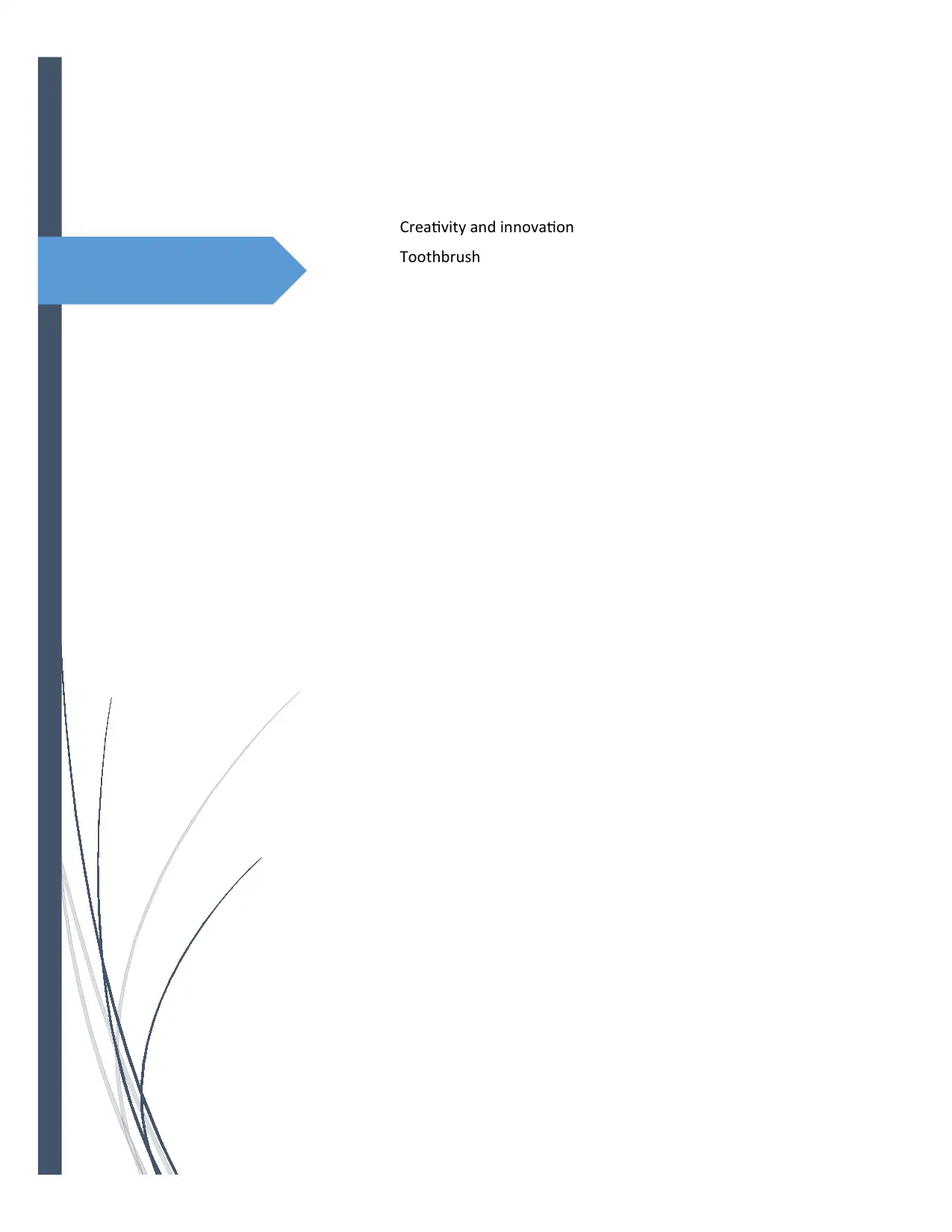
Creativity and innovation
Toothbrush
Toothbrush
Paraphrase This Document
Need a fresh take? Get an instant paraphrase of this document with our AI Paraphraser
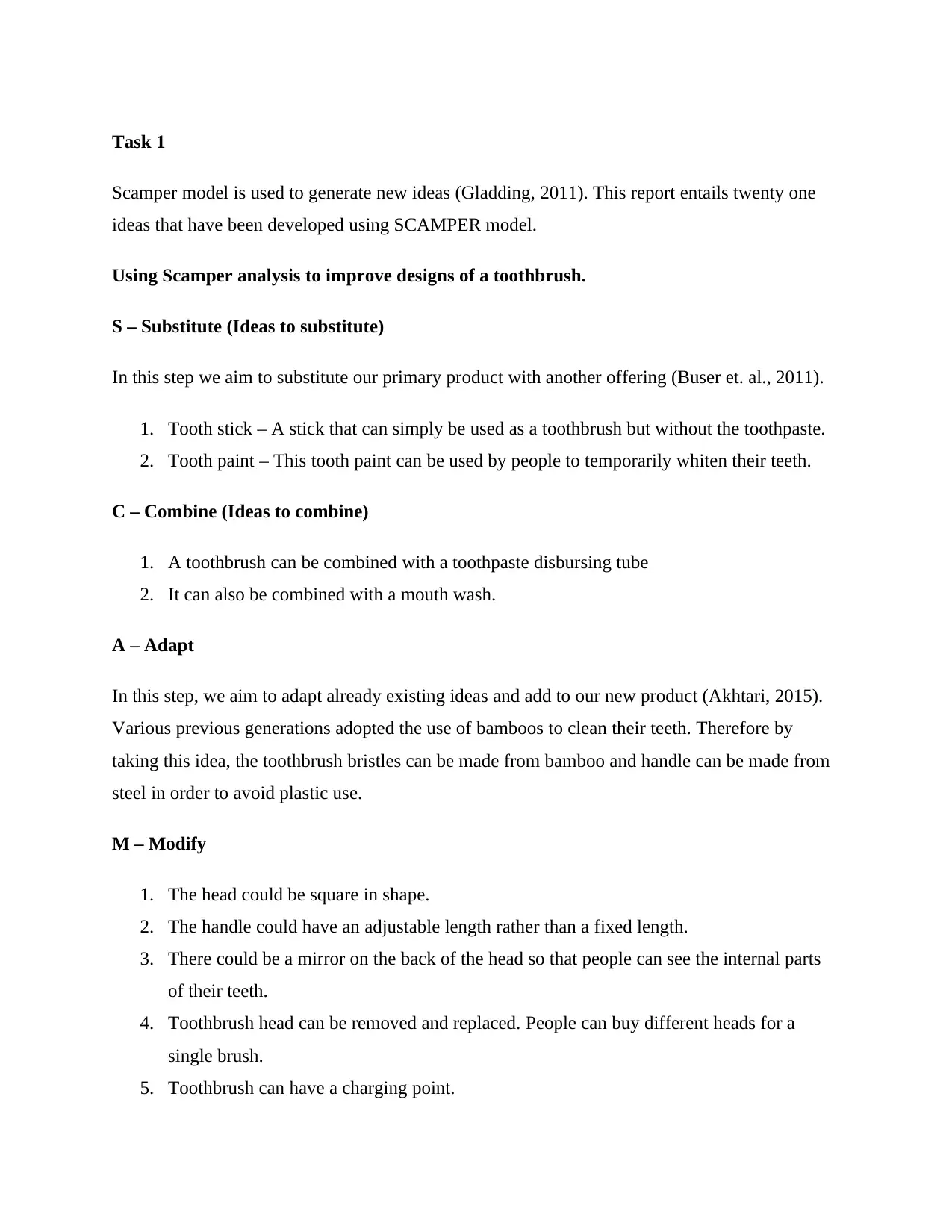
Task 1
Scamper model is used to generate new ideas (Gladding, 2011). This report entails twenty one
ideas that have been developed using SCAMPER model.
Using Scamper analysis to improve designs of a toothbrush.
S – Substitute (Ideas to substitute)
In this step we aim to substitute our primary product with another offering (Buser et. al., 2011).
1. Tooth stick – A stick that can simply be used as a toothbrush but without the toothpaste.
2. Tooth paint – This tooth paint can be used by people to temporarily whiten their teeth.
C – Combine (Ideas to combine)
1. A toothbrush can be combined with a toothpaste disbursing tube
2. It can also be combined with a mouth wash.
A – Adapt
In this step, we aim to adapt already existing ideas and add to our new product (Akhtari, 2015).
Various previous generations adopted the use of bamboos to clean their teeth. Therefore by
taking this idea, the toothbrush bristles can be made from bamboo and handle can be made from
steel in order to avoid plastic use.
M – Modify
1. The head could be square in shape.
2. The handle could have an adjustable length rather than a fixed length.
3. There could be a mirror on the back of the head so that people can see the internal parts
of their teeth.
4. Toothbrush head can be removed and replaced. People can buy different heads for a
single brush.
5. Toothbrush can have a charging point.
Scamper model is used to generate new ideas (Gladding, 2011). This report entails twenty one
ideas that have been developed using SCAMPER model.
Using Scamper analysis to improve designs of a toothbrush.
S – Substitute (Ideas to substitute)
In this step we aim to substitute our primary product with another offering (Buser et. al., 2011).
1. Tooth stick – A stick that can simply be used as a toothbrush but without the toothpaste.
2. Tooth paint – This tooth paint can be used by people to temporarily whiten their teeth.
C – Combine (Ideas to combine)
1. A toothbrush can be combined with a toothpaste disbursing tube
2. It can also be combined with a mouth wash.
A – Adapt
In this step, we aim to adapt already existing ideas and add to our new product (Akhtari, 2015).
Various previous generations adopted the use of bamboos to clean their teeth. Therefore by
taking this idea, the toothbrush bristles can be made from bamboo and handle can be made from
steel in order to avoid plastic use.
M – Modify
1. The head could be square in shape.
2. The handle could have an adjustable length rather than a fixed length.
3. There could be a mirror on the back of the head so that people can see the internal parts
of their teeth.
4. Toothbrush head can be removed and replaced. People can buy different heads for a
single brush.
5. Toothbrush can have a charging point.
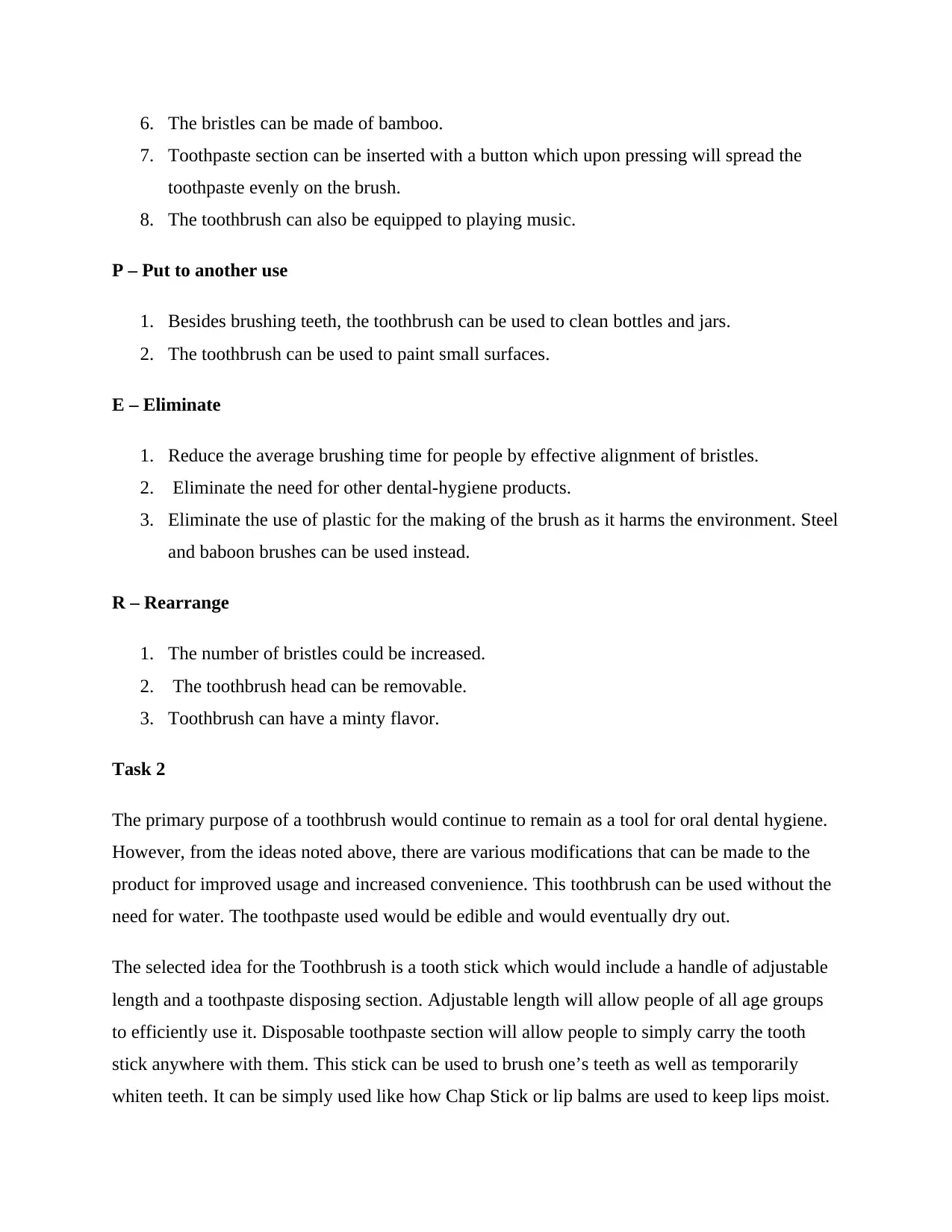
6. The bristles can be made of bamboo.
7. Toothpaste section can be inserted with a button which upon pressing will spread the
toothpaste evenly on the brush.
8. The toothbrush can also be equipped to playing music.
P – Put to another use
1. Besides brushing teeth, the toothbrush can be used to clean bottles and jars.
2. The toothbrush can be used to paint small surfaces.
E – Eliminate
1. Reduce the average brushing time for people by effective alignment of bristles.
2. Eliminate the need for other dental-hygiene products.
3. Eliminate the use of plastic for the making of the brush as it harms the environment. Steel
and baboon brushes can be used instead.
R – Rearrange
1. The number of bristles could be increased.
2. The toothbrush head can be removable.
3. Toothbrush can have a minty flavor.
Task 2
The primary purpose of a toothbrush would continue to remain as a tool for oral dental hygiene.
However, from the ideas noted above, there are various modifications that can be made to the
product for improved usage and increased convenience. This toothbrush can be used without the
need for water. The toothpaste used would be edible and would eventually dry out.
The selected idea for the Toothbrush is a tooth stick which would include a handle of adjustable
length and a toothpaste disposing section. Adjustable length will allow people of all age groups
to efficiently use it. Disposable toothpaste section will allow people to simply carry the tooth
stick anywhere with them. This stick can be used to brush one’s teeth as well as temporarily
whiten teeth. It can be simply used like how Chap Stick or lip balms are used to keep lips moist.
7. Toothpaste section can be inserted with a button which upon pressing will spread the
toothpaste evenly on the brush.
8. The toothbrush can also be equipped to playing music.
P – Put to another use
1. Besides brushing teeth, the toothbrush can be used to clean bottles and jars.
2. The toothbrush can be used to paint small surfaces.
E – Eliminate
1. Reduce the average brushing time for people by effective alignment of bristles.
2. Eliminate the need for other dental-hygiene products.
3. Eliminate the use of plastic for the making of the brush as it harms the environment. Steel
and baboon brushes can be used instead.
R – Rearrange
1. The number of bristles could be increased.
2. The toothbrush head can be removable.
3. Toothbrush can have a minty flavor.
Task 2
The primary purpose of a toothbrush would continue to remain as a tool for oral dental hygiene.
However, from the ideas noted above, there are various modifications that can be made to the
product for improved usage and increased convenience. This toothbrush can be used without the
need for water. The toothpaste used would be edible and would eventually dry out.
The selected idea for the Toothbrush is a tooth stick which would include a handle of adjustable
length and a toothpaste disposing section. Adjustable length will allow people of all age groups
to efficiently use it. Disposable toothpaste section will allow people to simply carry the tooth
stick anywhere with them. This stick can be used to brush one’s teeth as well as temporarily
whiten teeth. It can be simply used like how Chap Stick or lip balms are used to keep lips moist.
⊘ This is a preview!⊘
Do you want full access?
Subscribe today to unlock all pages.

Trusted by 1+ million students worldwide
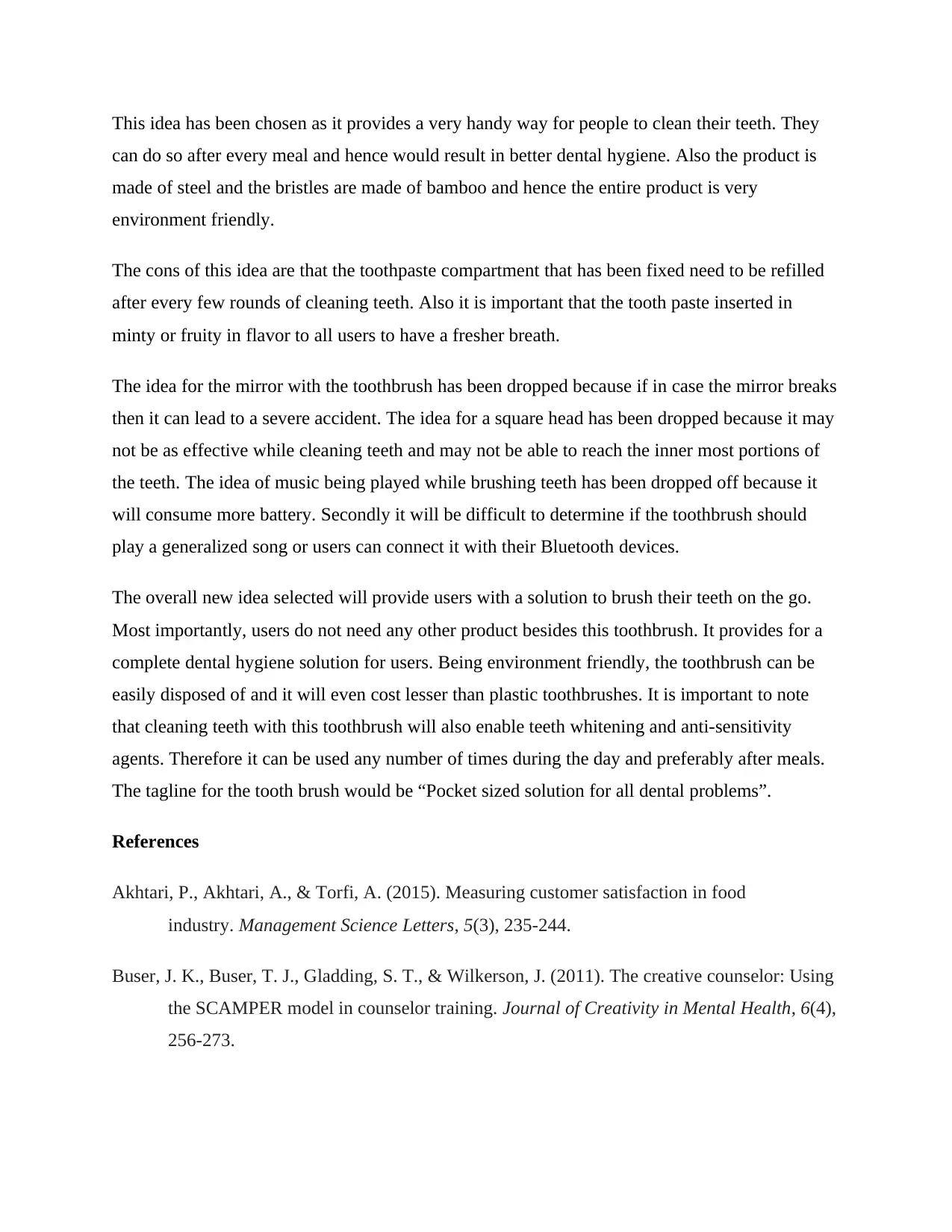
This idea has been chosen as it provides a very handy way for people to clean their teeth. They
can do so after every meal and hence would result in better dental hygiene. Also the product is
made of steel and the bristles are made of bamboo and hence the entire product is very
environment friendly.
The cons of this idea are that the toothpaste compartment that has been fixed need to be refilled
after every few rounds of cleaning teeth. Also it is important that the tooth paste inserted in
minty or fruity in flavor to all users to have a fresher breath.
The idea for the mirror with the toothbrush has been dropped because if in case the mirror breaks
then it can lead to a severe accident. The idea for a square head has been dropped because it may
not be as effective while cleaning teeth and may not be able to reach the inner most portions of
the teeth. The idea of music being played while brushing teeth has been dropped off because it
will consume more battery. Secondly it will be difficult to determine if the toothbrush should
play a generalized song or users can connect it with their Bluetooth devices.
The overall new idea selected will provide users with a solution to brush their teeth on the go.
Most importantly, users do not need any other product besides this toothbrush. It provides for a
complete dental hygiene solution for users. Being environment friendly, the toothbrush can be
easily disposed of and it will even cost lesser than plastic toothbrushes. It is important to note
that cleaning teeth with this toothbrush will also enable teeth whitening and anti-sensitivity
agents. Therefore it can be used any number of times during the day and preferably after meals.
The tagline for the tooth brush would be “Pocket sized solution for all dental problems”.
References
Akhtari, P., Akhtari, A., & Torfi, A. (2015). Measuring customer satisfaction in food
industry. Management Science Letters, 5(3), 235-244.
Buser, J. K., Buser, T. J., Gladding, S. T., & Wilkerson, J. (2011). The creative counselor: Using
the SCAMPER model in counselor training. Journal of Creativity in Mental Health, 6(4),
256-273.
can do so after every meal and hence would result in better dental hygiene. Also the product is
made of steel and the bristles are made of bamboo and hence the entire product is very
environment friendly.
The cons of this idea are that the toothpaste compartment that has been fixed need to be refilled
after every few rounds of cleaning teeth. Also it is important that the tooth paste inserted in
minty or fruity in flavor to all users to have a fresher breath.
The idea for the mirror with the toothbrush has been dropped because if in case the mirror breaks
then it can lead to a severe accident. The idea for a square head has been dropped because it may
not be as effective while cleaning teeth and may not be able to reach the inner most portions of
the teeth. The idea of music being played while brushing teeth has been dropped off because it
will consume more battery. Secondly it will be difficult to determine if the toothbrush should
play a generalized song or users can connect it with their Bluetooth devices.
The overall new idea selected will provide users with a solution to brush their teeth on the go.
Most importantly, users do not need any other product besides this toothbrush. It provides for a
complete dental hygiene solution for users. Being environment friendly, the toothbrush can be
easily disposed of and it will even cost lesser than plastic toothbrushes. It is important to note
that cleaning teeth with this toothbrush will also enable teeth whitening and anti-sensitivity
agents. Therefore it can be used any number of times during the day and preferably after meals.
The tagline for the tooth brush would be “Pocket sized solution for all dental problems”.
References
Akhtari, P., Akhtari, A., & Torfi, A. (2015). Measuring customer satisfaction in food
industry. Management Science Letters, 5(3), 235-244.
Buser, J. K., Buser, T. J., Gladding, S. T., & Wilkerson, J. (2011). The creative counselor: Using
the SCAMPER model in counselor training. Journal of Creativity in Mental Health, 6(4),
256-273.
Paraphrase This Document
Need a fresh take? Get an instant paraphrase of this document with our AI Paraphraser
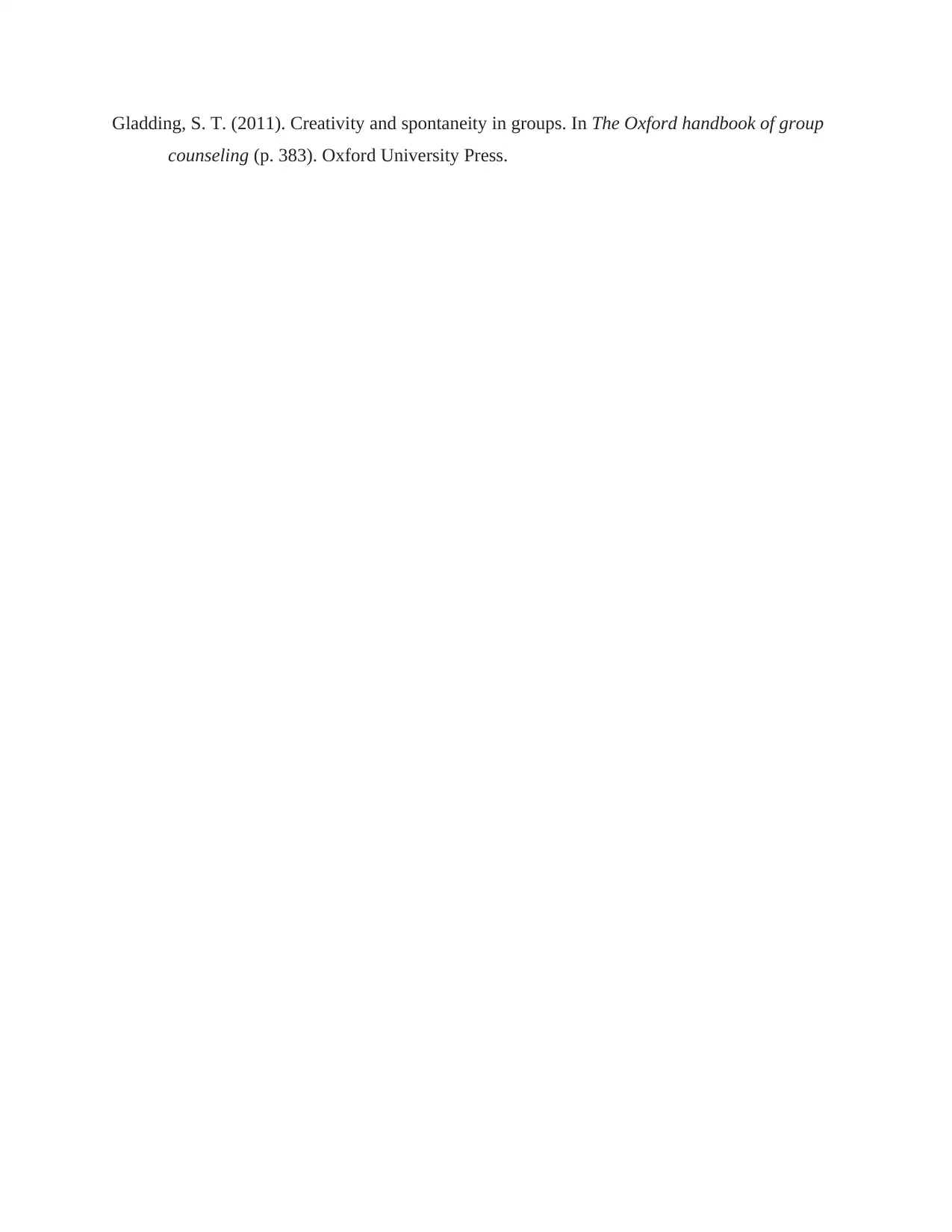
Gladding, S. T. (2011). Creativity and spontaneity in groups. In The Oxford handbook of group
counseling (p. 383). Oxford University Press.
counseling (p. 383). Oxford University Press.
1 out of 5
Your All-in-One AI-Powered Toolkit for Academic Success.
+13062052269
info@desklib.com
Available 24*7 on WhatsApp / Email
![[object Object]](/_next/static/media/star-bottom.7253800d.svg)
Unlock your academic potential
Copyright © 2020–2025 A2Z Services. All Rights Reserved. Developed and managed by ZUCOL.


